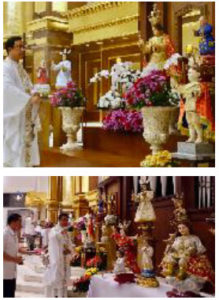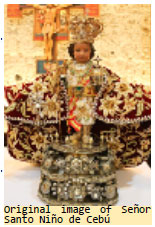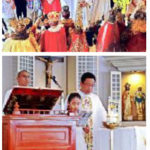Christ the King Parish Celebrates the Feast of the Sto. Niño, January 21
 The Parish celebrated the Feast of the Sto. Niño last January 21. In commemoration of the feast of the Child Jesus, all the CTK masses, including the January 20 anticipated masses, featured the special blessing of children and the blessing of beautiful Sto. Niño images borrowed from or donated by parishioners.
The Parish celebrated the Feast of the Sto. Niño last January 21. In commemoration of the feast of the Child Jesus, all the CTK masses, including the January 20 anticipated masses, featured the special blessing of children and the blessing of beautiful Sto. Niño images borrowed from or donated by parishioners.
Devotion to the Santo Niño (Holy Child), an image of Jesus as a small boy typically dressed as a king, is a mainstay of Philippine Catholic life.
The oldest and most popular Santo Niño image is the Santo Niño of Cebu City, originally given in 1521 as a gift by explorer Ferdinand Magellan to Rajah Humabon and his wife when he landed on the island. The statue measures approximately twelve inches tall, is made of a dark wood in Qlemish style and depicts the Child Jesus as a king dressed like Spanish royalty. The expressions, accessories and hand posture of Santo Niño de Cebu are similar to the Infant Jesus of Prague . It is believed that both statues originated from the same European source, with the devotion to Santo Nino starting earlier of the two . Th e statue is clothed in rich fabrics, wears jewelry such as gilded neck chain and bears imperial regalia including a gold crown, globus cruciger, and various sceptres mostly donated by devotees.
 In Cebu, devotion to the Santo Niño reaches a fever pitch early in January, when crowds flock to the basilica that houses it, and the city and its harbor are taken over for days by processions, colorful parades and other celebrations. The name of that feast, Sinulog, refers to a ritual dance inspired by and performed before the Santo Niño. In recent years the events have drawn 1.5 to 3 million participants in a city of fewer than 900,000 people, making Cebu’s celebration one of the largest annual events in the Catholic world.
In Cebu, devotion to the Santo Niño reaches a fever pitch early in January, when crowds flock to the basilica that houses it, and the city and its harbor are taken over for days by processions, colorful parades and other celebrations. The name of that feast, Sinulog, refers to a ritual dance inspired by and performed before the Santo Niño. In recent years the events have drawn 1.5 to 3 million participants in a city of fewer than 900,000 people, making Cebu’s celebration one of the largest annual events in the Catholic world.


